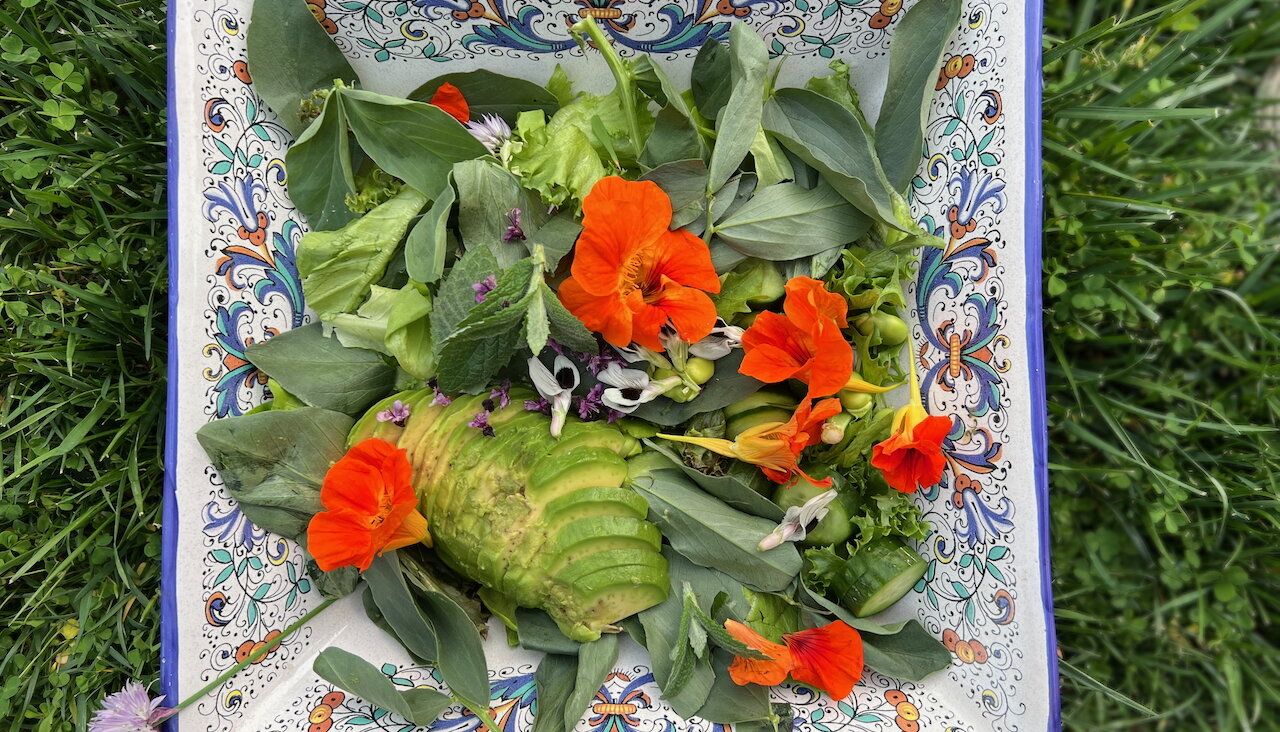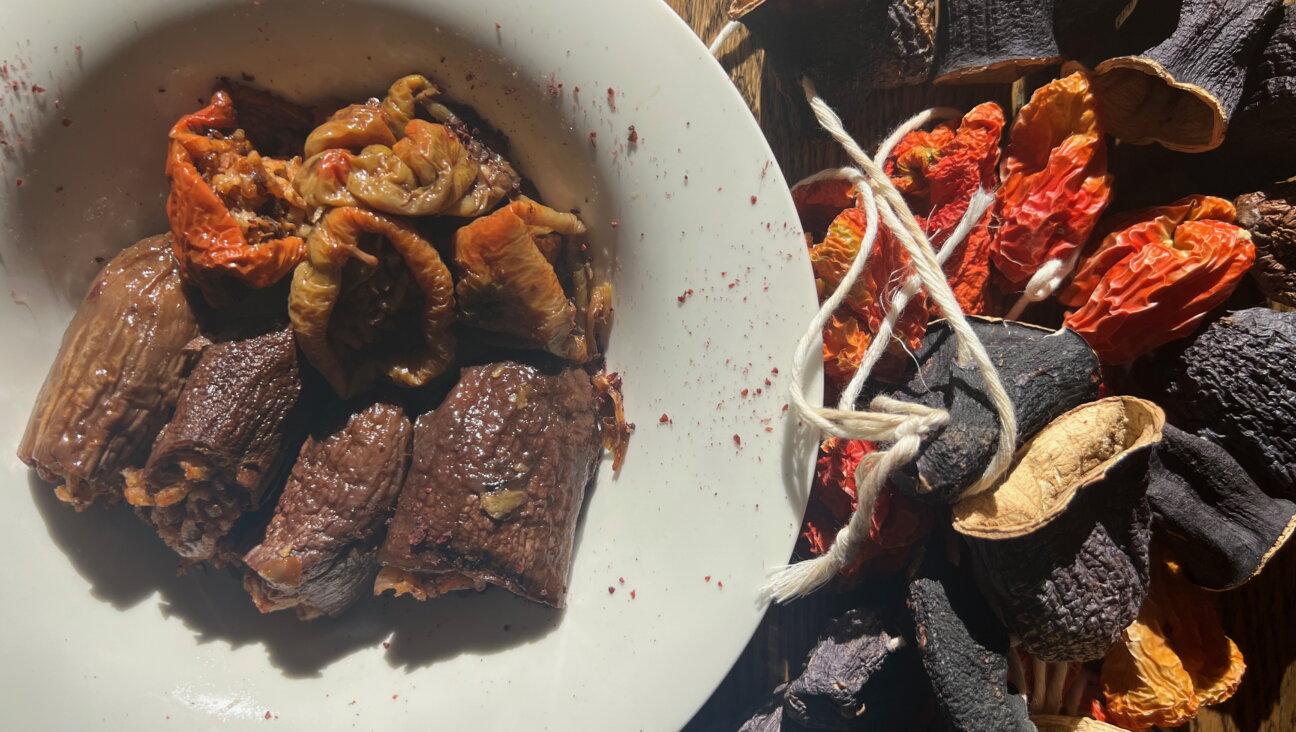Pumpkin knishes and spicy pumpkin dip: Jews and pumpkins go back long before Thanksgiving

A 1948 advertisement in the Forverts featured a recipe for coconut pumpkin chiffon pie. The full ad is below. Image by Forward Association
I love pumpkin. I love it in a sweet dessert, I love it in a savory stew, and — I’m not afraid to say it — I love it in my morning latte. But I’ve never imagined my ancestors who lived in a Belarussian shtetl would have felt the same.
Jews, it turns out, were really into pumpkin long before Thanksgiving made it popular.

You can still find a big pumpkin knish at the Knishery NYC Courtesy of Knishery NYC
Pumpkin is well known as a product of the New World, first domesticated in the area of northeastern Mexico and the southern United States 7,000-9,000 years ago. It wasn’t encountered by Europeans, let alone Eastern European Jews, until after the first European settlers arrived in the Western hemisphere.
But before they arrived in America, Jews of the Old World likely already enjoyed pumpkin.
At least one piece of Yiddish literature, suggests that by the early 20th century pumpkin and more specifically pumpkin knishes were well recognizable to Yiddish-speaking Jews in the Soviet Union.
Knishes are available from street vendors across New York City, but traditional knish fillings are potato, buckwheat groats and cheese.
Yiddish Poet Leyb Kvitko had different ideas though. Kvitko, a Yiddish childrens writer and member of the Jewish Anti-Fascist Comittee during the Second World War, would ultimately be murdered alongside 13 other Yiddish authors at Moscow’s Lyubyanka prison on August 12, 1952 — the infamous Night of Murdered Poets.
In the 1920s however, he was becoming a rock star to Yiddish-speaking Soviet Jewry for his children’s books written and illustrated in the Soviet realist style.
Published in 1926 in Kharkov, then the capital of the Ukrainian SSR, Kvitko’s rhyming children’s story, “Di Bubbe Shlok Un Ir Kabak” (Grandma Shlok and Her Pumpkin), tells the tale of Jewish grandmother who finds one day finds a massive pumpkin in her garden.
In contrast to Roald Dahl’s tale of a boy and his giant peach, when confronted with a giant pumpkin, Kvitko’s Bubbe Shlok’s first thoughts go to the kitchen.
“There would be endless knishes for the town and for the village,” Kvitko writes in rhyming Yiddish. When her grandchildren excitedly came to see the oddity, they asked if she could cut them slices, and bubbe Shlok responds that if they can manage to move it, she’ll even make them knishes.
After reading that story, I know that my Ashkenazi family has nearly a century of pumpkin knish-less Thanksgivings to make up for.
In contrast to the Ashkenazi culinary tradition of Eastern Europe, Mediterranean Jewish communities, who long had ties with Spanish and Portuguese traders returning from the New World, offer many more traditionally Jewish pumpkin dishes. Though pumpkin is usually associated with Rosh Hashanah in many Sephardic traditions, they’ll be just as good for your Thanksgiving table.
Libyan Jewish pumpkin dip is an appetizer, to be served with bread or raw vegetables. It has a spicer version hailing from Tunisia, known as Tirshi.
Farther afield in Central Asia, Oshi Tos Kadu, a festive Bukharian dish, involving a whole pumpkin stuffed with rice, apples and raisins is sure to wow guests.

A 1948 advertisement in the Forverts featured a recipe for coconut pumpkin chiffon pie. The full ad is below. Image by Forward Association
When Jews from these faraway lands arrived in America, Thanksgiving may have been new, but pumpkin wasn’t. By the 1940s, the Forward was already offering American pumpkin pie spice recipes translated into Yiddish for newly arrived immigrants.
Thanks, but I’d rather have the knish.
The Forward is free to read, but it isn’t free to produce

I hope you appreciated this article. Before you go, I’d like to ask you to please support the Forward.
Now more than ever, American Jews need independent news they can trust, with reporting driven by truth, not ideology. We serve you, not any ideological agenda.
At a time when other newsrooms are closing or cutting back, the Forward has removed its paywall and invested additional resources to report on the ground from Israel and around the U.S. on the impact of the war, rising antisemitism and polarized discourse.
This is a great time to support independent Jewish journalism you rely on. Make a gift today!
— Rachel Fishman Feddersen, Publisher and CEO
Support our mission to tell the Jewish story fully and fairly.
Most Popular
- 1

Fast Forward Ye debuts ‘Heil Hitler’ music video that includes a sample of a Hitler speech
- 2

Opinion It looks like Israel totally underestimated Trump
- 3

Culture Cardinals are Catholic, not Jewish — so why do they all wear yarmulkes?
- 4

Fast Forward Student suspended for ‘F— the Jews’ video defends himself on antisemitic podcast
In Case You Missed It
-

Culture Should Diaspora Jews be buried in Israel? A rabbi responds
-

Fast Forward In first Sunday address, Pope Leo XIV calls for ceasefire in Gaza, release of hostages
-

Fast Forward Huckabee denies rift between Netanyahu and Trump as US actions in Middle East appear to leave out Israel
-

Fast Forward Federal security grants to synagogues are resuming after two-month Trump freeze
-
Shop the Forward Store
100% of profits support our journalism
Republish This Story
Please read before republishing
We’re happy to make this story available to republish for free, unless it originated with JTA, Haaretz or another publication (as indicated on the article) and as long as you follow our guidelines.
You must comply with the following:
- Credit the Forward
- Retain our pixel
- Preserve our canonical link in Google search
- Add a noindex tag in Google search
See our full guidelines for more information, and this guide for detail about canonical URLs.
To republish, copy the HTML by clicking on the yellow button to the right; it includes our tracking pixel, all paragraph styles and hyperlinks, the author byline and credit to the Forward. It does not include images; to avoid copyright violations, you must add them manually, following our guidelines. Please email us at [email protected], subject line “republish,” with any questions or to let us know what stories you’re picking up.
















